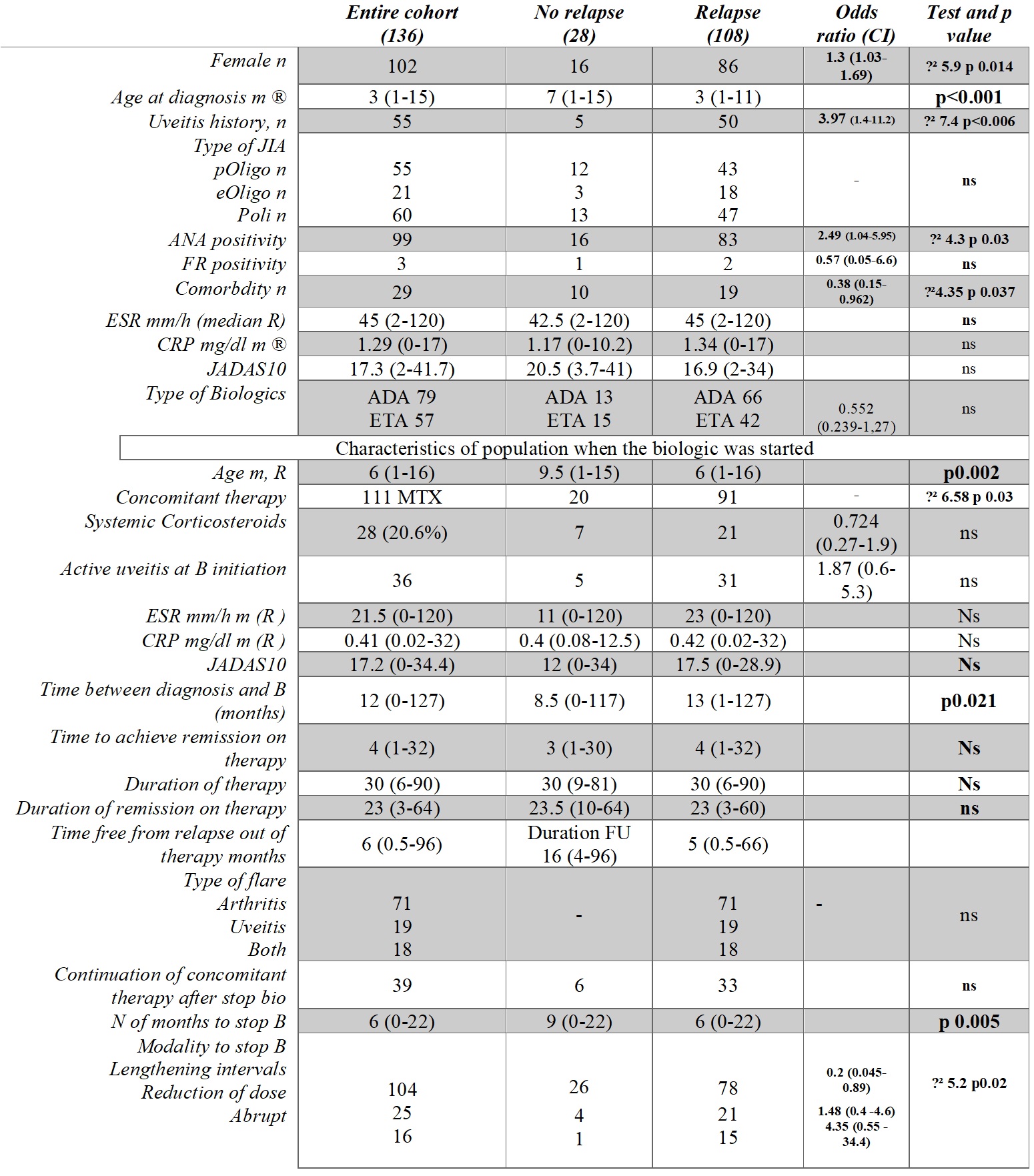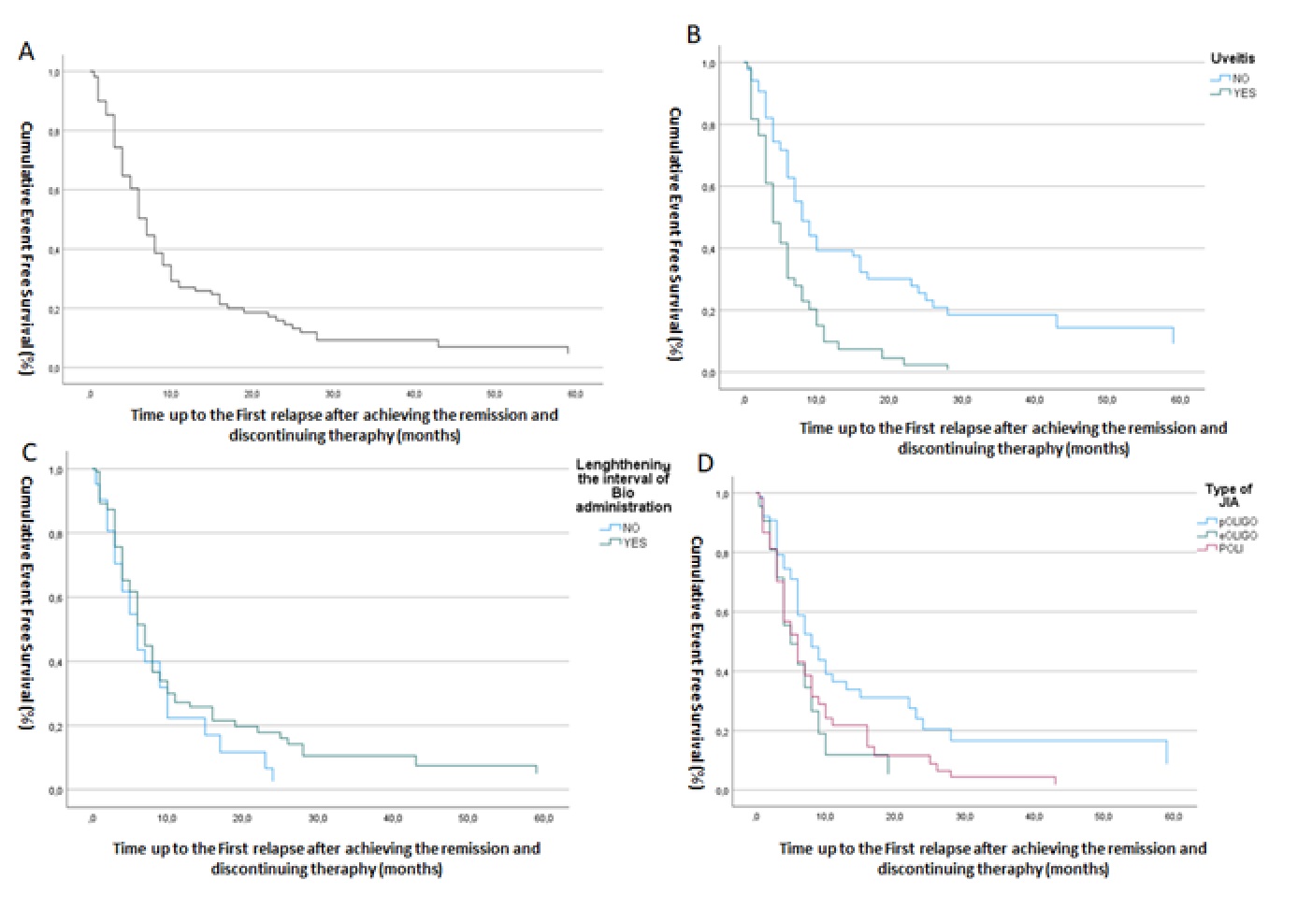Session Information
Session Type: Abstract Session
Session Time: 2:00PM-3:30PM
Background/Purpose: TNF inhibitors (TNFi) have dramatically changed the prognosis of Juvenile Idiopathic Arthritis (JIA). However, once achieved disease remission, it is not clear how and when withdraw the therapy. We aim to describe a multicentric cohort of JIA treated with Adalimumab or Etanercept who discontinued the treatment for persistent remission and identify factors associated with relapse.
Methods: In a multicentric Italian retrospective cohort study (Florence, Brescia, Trieste and Bari), medical records of patients with oligoarticular and polyarticular JIA were evaluated if they stopped therapy for persistent remission after the first course of TNFi. We collected demographic, clinical and laboratory data at onset and during biologic treatment.
Results: 136 patients were enrolled (102 female, median age at onset 3 years (R1-15)), of whom 76 (55.9%) had oligoarticular JIA, 55 (40.4%) uveitis and 99 (72.8%) ANA positivity. Adalimumab (59.3%) and Etanercept (40.7%) were started at a median age of 6 years (R1-16). Remission was achieved after a median time of 4 months (R 1-32) and TNFi were discontinued after a median time of 30 months (R 6-90), increasing the interval of administration in 76.5%, reducing the dose in 18.4% and abrupt discontinuation in16.9%. The 79.4% of patients relapsed after a median time of 5 months (R 0.5-66) and they were more likely female (ꭓ² 5.9 p< 0.014), younger at onset (p< 0.001) and TNFi initiation (p 0.002), to have uveitis (ꭓ² 7.4 p< 0.006), longer time to TNFi initiation (p0.02), shorter time of weaning therapy (p0.005) and discontinued therapy not lengthening intervals of administration (ꭓ² 5.2 p0.015). Moreover, patients with uveitis and who not lengthening the interval of administration have earlier relapse evaluated with Kaplan-Meier curve (Log Rank χ² = 16.4 p < 0.0001 and χ² = 6.95 p 0.008). Cox regression showed as independent predictors for time to relapse uveitis (HR 2.25 CI 1.41 – 3.57), age at onset (HR 0.907 CI 0.830-0.991), duration of tapering (HR 0.928 CI 0.875 -0.985) and to have a pOligo (HR 0.59 CI 0.361-0.978)(χ² = 32.9 p0.001). Stratifying the curve by uveitis, JIA categories and tapering modalities the curves showed respectively that patients with uveitis and who do not lengthened the interval of administration relapsed earlier compared to the others (respectively Log Rank χ² = 20.54 p0.025 and Log Rank χ² = 30.3 p0.001), while patients with pOligo relapse later compared to the other (Log Rank χ² = 31.9 p< 0.001)
Conclusion: Early age at onset, uveitis, duration of tapering and to have pOligo seem to be independent risk factors for earlier relapse after first Anti-TNF withdrawal.
To cite this abstract in AMA style:
Maccora I, Accardo V, Cattalini M, Pagnini i, Taddio A, Marrani E, La Torre f, Trevisan M, Mastrolia M, Simonini G. Uveitis as Predictor of Disease Flare After the First Course of Anti-TNF Withdrawal in Oligo and Polyarticular Juvenile Idiopathic Arthritis: A Multicentric Italian Experience [abstract]. Arthritis Rheumatol. 2023; 75 (suppl 9). https://acrabstracts.org/abstract/uveitis-as-predictor-of-disease-flare-after-the-first-course-of-anti-tnf-withdrawal-in-oligo-and-polyarticular-juvenile-idiopathic-arthritis-a-multicentric-italian-experience/. Accessed .« Back to ACR Convergence 2023
ACR Meeting Abstracts - https://acrabstracts.org/abstract/uveitis-as-predictor-of-disease-flare-after-the-first-course-of-anti-tnf-withdrawal-in-oligo-and-polyarticular-juvenile-idiopathic-arthritis-a-multicentric-italian-experience/


